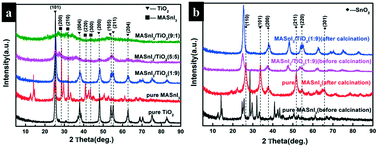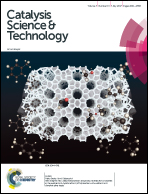Lead-free organic–inorganic hybrid perovskite heterojunction composites for photocatalytic applications
Abstract
Heterojunction structured MASnI3/TiO2 photocatalysts (MA represents CH3NH3+) are prepared via a facile wet-chemical method and characterized by various techniques. The characterization demonstrates the formation of a heterojunction structure and the good crystallinity of MASnI3/TiO2 (1 : 9) (mass ratio of MASnI3 and TiO2 is 1 : 9). Moreover, the results also display the improved visible light absorption of MASnI3/TiO2 (1 : 9) and low recombination of photoinduced carriers. As a result, MASnI3/TiO2 (1 : 9) could completely degrade rhodamine B (97%) in 40 min, which has higher photocatalytic ability than pure MASnI3 and pure TiO2. The improved photocatalytic activity could be ascribed to the improved light harvesting ability and easy transfer of photogenerated carriers of the materials generated by the formation of a heterojunction structure and the suitable energy band position between MASnI3 and TiO2. In particular, coupling of MASnI3 and TiO2 could also avoid oxidation and hydrolysis of MASnI3 so that the long-term stability of the composite could be efficiently maintained. It is the first report on MASnI3 and TiO2 composites being used as photocatalysts for dye degradation. A possible mechanism for the enhancement of photocatalytic activity under light irradiation is also proposed.

- This article is part of the themed collection: 2017 Catalysis Science & Technology HOT Articles


 Please wait while we load your content...
Please wait while we load your content...